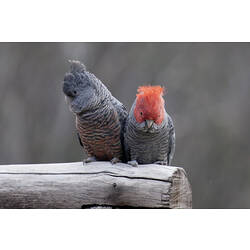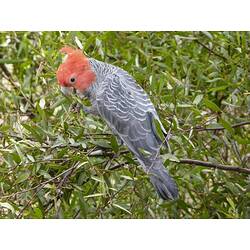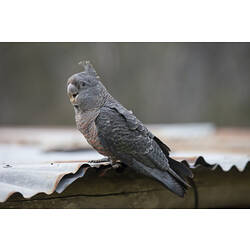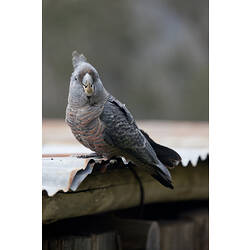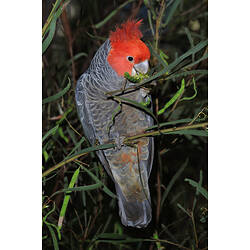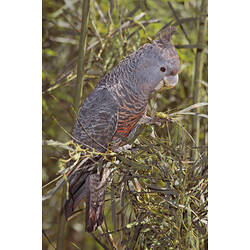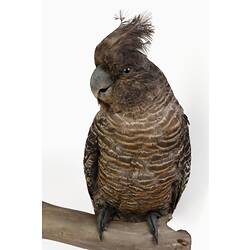General Description
Cockatoo with grey body. Wings and upperparts of feathers a lighter pale-grey producing a barred appearance. Males have a distinctive orange-red head with a small floppy red crest. Females have a dark grey head and crest, with the feathers on the breast being edged yellow and pink. Bill to tail length is up to 35 cm. Call a distinctive screech that sounds similar to the creaking sound of a door being opened.
Biology
Gang-gang Cockatoos pair for life. They nest in deep hollows in trees and pairs will usually return to the same tree every year. They begin breeding at four years old and breed between October and January. Females lay up to three eggs and both parents will incubate and rear the young. Gang-gangs are gregarious social birds and several pairs will often nest close together. The young often congregate while the parents are out foraging for food. Gang-gang Cockatoos migrate seasonally, spending winter in drier lowland areas, such as open eucalypt forests and woodlands, and moving to higher areas in summer, generally tall mountain forests and woodlands. They are sometimes also seen in urban areas in the winter. In comparison to other cockatoo species, they are relatively quiet and can be located by the sounds of falling debris from the trees that they are foraging in. They feed primarily on seeds, preferably of eucalypts and wattles, but will also eat insects, nuts, fruits and berries.
Distribution
South-eastern mainland Australia.
Habitat
Wet forests and woodlands in mountain areas, occasionally in urban areas.
More Information
-
Animal Type
-
Animal SubType
-
Brief Id
A stocky grey cockatoo with a floppy crest of red or dark grey feathers.
-
Colours
Grey, Red
-
Maximum Size
35 cm
-
Habitats
-
Diet
Omnivore
-
Diet Categories
Seeds, Fruit, Insects
-
Endemicity
-
Commercial
No
-
Conservation Statuses
CITES: Trade restrictions (Appendix II), FFG Threatened List: Endangered, EPBC Act 1999: Endangered, IUCN Red List: Least Concern
-
Taxon Name
-
Common Name
Gang-gang Cockatoo
-
Kingdom
-
Phylum
-
Subphylum
-
Class
-
Order
-
Family
-
Genus
-
Species Name
fimbriatum

